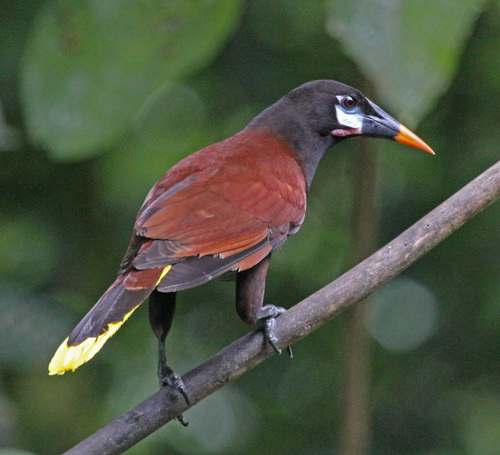
Montezuma Oropendola
The Montezuma Oropendola (*Psarocolius montezuma*) is a striking New World tropical bird renowned for its unique pendulum-like nests and distinctive vocalizations. It plays a significant role in its ecosystem as a seed disperser and insectivore. This species holds cultural significance in some regions of Central America, often appearing in folklore and local traditions. Its large, colonial nests are a conspicuous feature of the landscape, often adorning trees in open woodlands and forest edges.
35-50 cm
Length
Not Evaluated cm
Wingspan
Least Concern
Conservation Status
Distribution
The Montezuma Oropendola is found along the Caribbean slope from southeastern Mexico to central Panama. It does not typically undertake long-distance migrations but may move locally in response to food availability.
Lifespan
Up to 15-17 years in the wild is estimated, but precise data are limited. Captive birds may live longer.
Montezuma Oropendola's Habitat
Habitat Types
Humid lowland forests, Forest edges, Partially cleared areas, Plantations (e.g., cacao, banana)
Climate Zones
Tropical
Adaptations
Their strong bills are adapted for consuming a variety of foods, from fruits and nectar to insects and small vertebrates. Their agile feet allow them to navigate branches and hang upside down while foraging or building nests.
Variations
No widely recognized subspecies exist, though some minor plumage variations may occur across its range.
Appearance
Breeding Plumage
Plumage is generally consistent year-round, though breeding males may exhibit slightly brighter colors.
Seasonal Feather Changes
Minimal seasonal variation.
Sex Based Plumage Differences
Males are chestnut brown with blackish heads and rumps. Females are similar but duller and smaller. Both sexes have bright yellow outer tail feathers.
Notable Features
Bare, blue cheek patch, Pink base of the bill, Long, pendulous nests, Bright yellow outer tail feathers
Diet and Feeding
Primary Foods
Fruit, Insects, Nectar, Small vertebrates (e.g., frogs, lizards)
Foraging Behavior
Oropendolas forage actively in trees and shrubs, often hanging upside down to reach fruit or probe for insects. They are also known to visit flowers for nectar.
Specializations
Their strong, pointed bill is versatile, allowing them to consume a wide range of food items.
Seasonal Diet Variations
Diet may shift slightly depending on fruit and insect availability. For example, they may consume more nectar during flowering seasons.
Behavior
Social Structure
Highly colonial, often nesting in groups of 30-150 or more nests in a single tree. A single dominant male typically controls a colony with multiple females.
Communication
Loud, gurgling calls (especially by males), Rattling sounds, Visual displays (bowing, wing spreading)
Migration
Not migratory, but may make local movements in response to food availability.
Territorial or Group Behaviors
Dominant males defend the colony from other males. Females may compete for nesting sites within the colony.
Conservation
Threats
Habitat loss (deforestation), Nest predation (by snakes, monkeys, and other birds), Brood parasitism (by giant cowbirds, in some areas)
Protection Programs
General habitat conservation efforts in protected areas
Local National Laws
Protected under general wildlife laws in many countries within its range.
Population Trend
Stable
Population Estimates
Not Evaluated
Interesting Facts
The name "Montezuma" refers to the Aztec emperor Moctezuma II.
The bird's impressive appearance likely led to its association with royalty.
Their nests can be over 2 meters long.
These elaborate structures are woven by the females.
Oropendolas often nest near wasp or bee nests.
This provides some protection from predators, as the wasps or bees will defend the area.
The male's call is a loud, unforgettable gurgle.
This distinctive sound is a key part of their courtship display.
Faqs about Montezuma Oropendola
Are Montezuma Oropendolas aggressive?
Males can be aggressive in defending their colonies, but they are not generally aggressive towards humans unless their nests are threatened.
Do they mate for life?
They are polygynous, meaning one male mates with multiple females in a colony.
What eats Montezuma Oropendolas?
Predators include snakes, monkeys, hawks, and other raptors that may prey on eggs, nestlings, or adults.
How can I attract Montezuma Oropendolas to my yard?
They are unlikely to be attracted to typical backyard feeders. Maintaining large trees and native vegetation in areas within their natural range may provide suitable habitat.
Copyright @ Nature Style Limited. All Rights Reserved.
 English
English